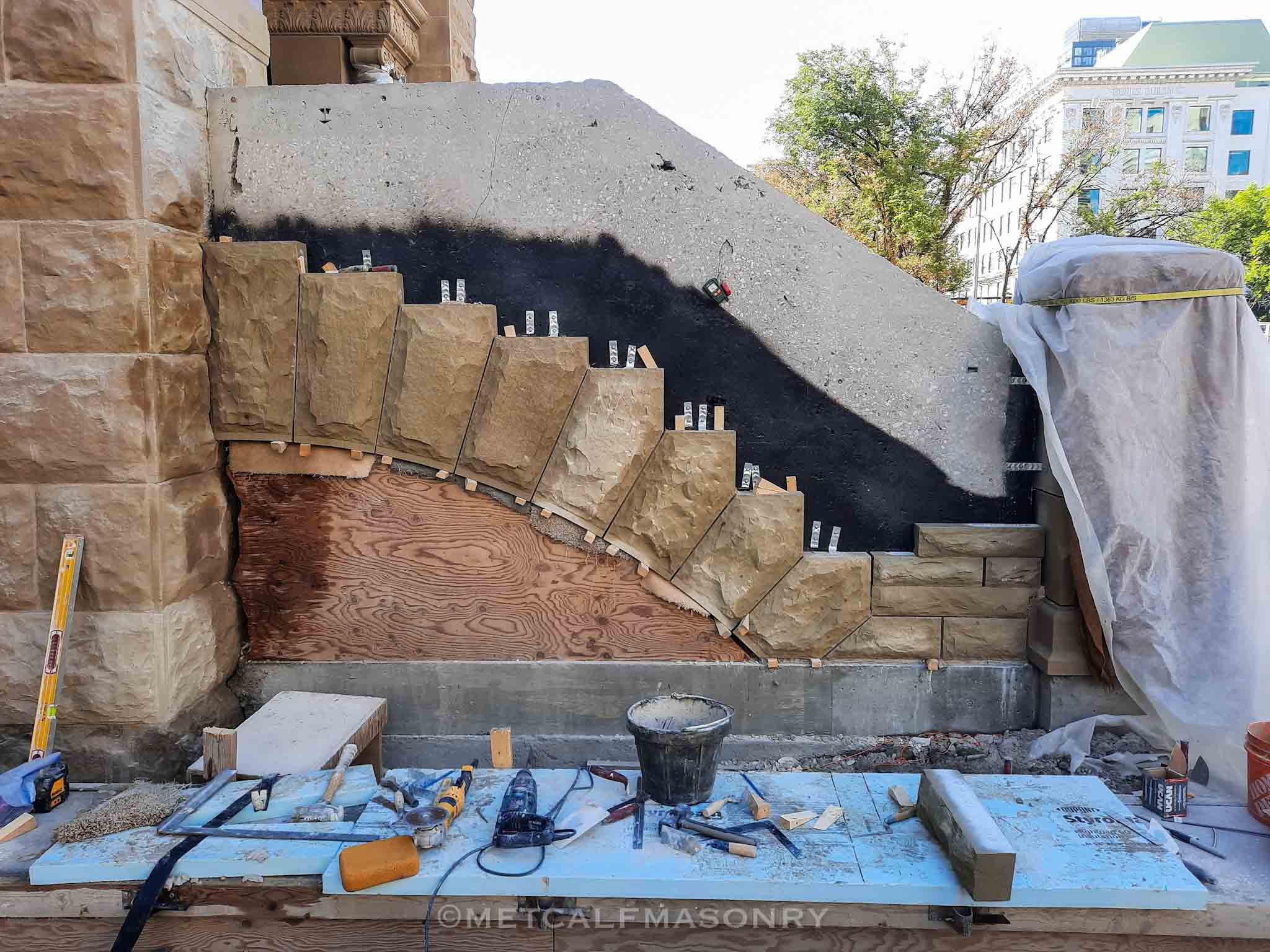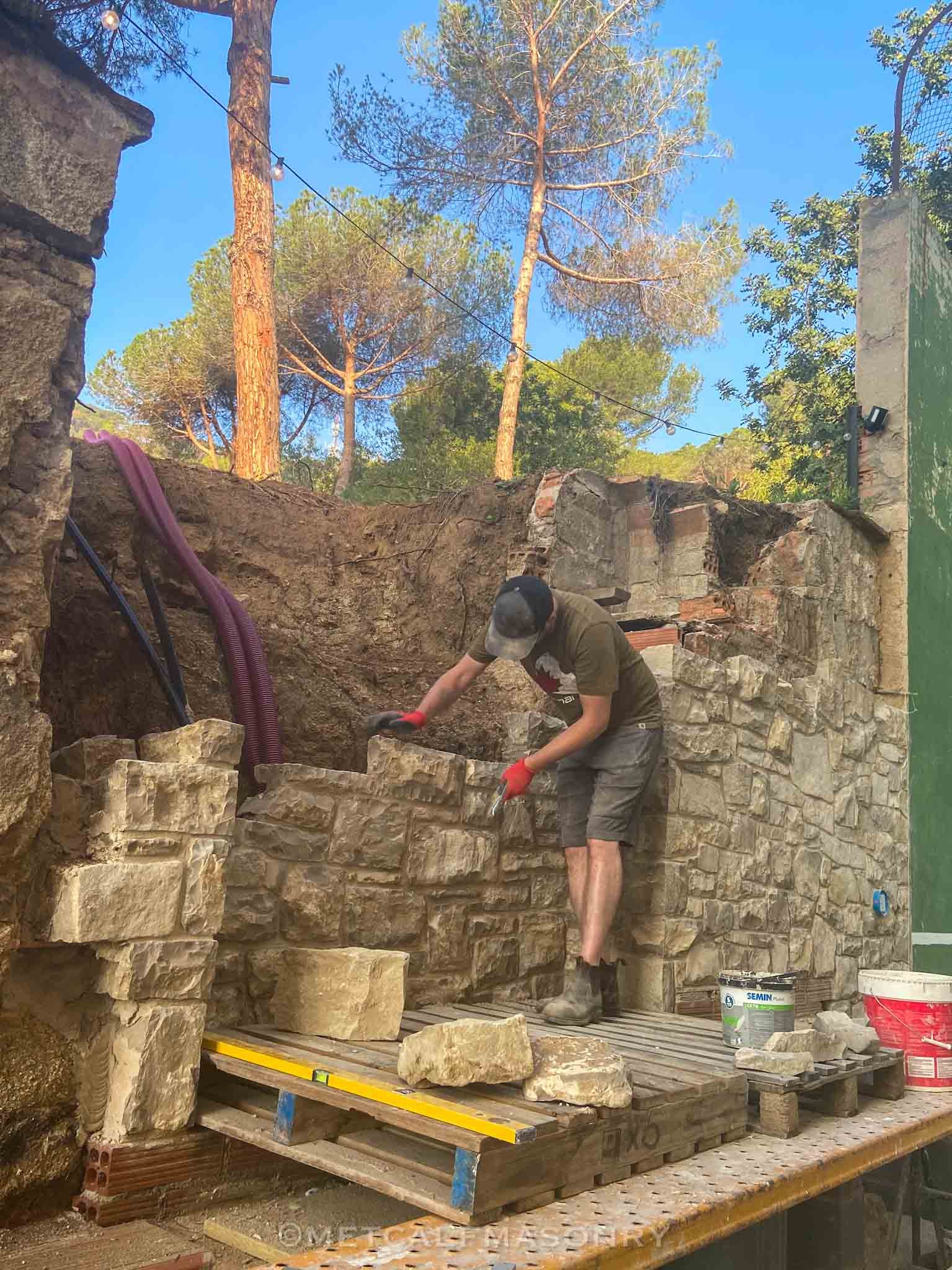
Owner Austin Metcalf
About Metcalf Masonry
The creativity of masonry is what I love about it, and I’ve learned a lot from many different skilled artisans from all over the world. With mortar and stone you can build anything you can dream of – but it takes experience and knowledge to make it possible. There is no building material in the world that is more fashionable or more elegant than stone. It is the enduring favourite of almost all cultures.
Since 2010 I’ve had the pleasure of working on projects across Canada and Spain, from classical buildings to beautiful custom homes. I’m based in the Okanagan, and will travel within BC and southern Alberta. Some of the more distinct projects where I gained my experience include:
5 years of working on the West Block of Parliament in Ottawa ON, where I completed my apprenticeship. I was involved in major re-building projects including the chimneys and spires of the Mackenzie tower and the north colonnade. I also learned to cut stone by hand efficiently in the shop, and many other skills involving the handling and restoration of historical valuable materials.
3 years working on the Old Calgary city hall, where I managed a large rebuild of the south portico. We cut and hoisted many large stones there without damage, and rebuilt it to specifications by the millimeter. I learned many conservation techniques throughout the rest of the building including mortar patches, re-pointing, crack repairs, efflorescence and paint removal, and the cutting and installing of "dutchmen" to name a few.
2 years working on high end custom homes in West Vancouver and Whistler. I learned from some creative masons while we were working on very unique custom homes. For example: I learned how to build tight fitting stone floors, which we made perfectly flat by selecting and flattening the large stones. Using various welding torches, we could spall the tool marks off the stones and make it look completely natural and flat. It made a shocking impression throughout the entire house, pool, driveway, walkways and stairs.
5 more years working across the industry, including the Jack Singer Concert Hall and Historic YWCA in Calgary, the Province House in Charlottetown PEI, and commercial and residential brick and block jobs throughout BC, Alberta, and Ontario. Everything I've learned from these experiences can relate and add value to your project.
Here are just some of the examples of services we provide. Please contact us and we would be happy to discuss any masonry project.
Stone Veneer
We can make natural stone veneer look unique by only using hand tools to make a perfect dry fit. Or we can make the stones stand out and look alive with the elegance of a mortar joint finished in a colour that enhances the beauty of the stone.
Our veneer fireplace surrounds and indoor/outdoor walls make the house look structurally made out of stone, giving a unique style and enhancing its value. We can hand carve large corner stones with sharp 90-degree edges to make the wall look thick and add strength to the appearance of your home. Hand cut fireplace hearths and mantels will also enhance the look and feel pleasant to the touch.
Manufactured Stone
Having the knowledge of working with natural stone allows us to make small adjustments to manufactured stone so the walls stand out as unique. By dedicating a little more time to adjusting manufactured stone, it can will be noticeably more visually pleasing and it will be built with higher quality. This option is optimal to keep material more affordable.
Fireplaces
We are experienced builders of Rumford fireplaces and the surrounds of fireplace inserts. Built to last and featuring any kind of detail, here are some of the materials we use: river rock, rubble, or brick.
Dry stone walling, retaining walls
Dry-laid stone is a common building practice in Catalonia, Spain. This technique of coursing and battering of different heights and widths of stone to interlock together makes very strong retaining walls and structures. All stones are cut and split by hand tools. Perfect for making a timeless beautiful retaining wall that matches function with an old-world style that looks good anywhere.
Firepits, Pizza ovens and BBQ’s
Stone and brick will have a great effect on your guests, enhancing these social spaces. A stone floor around a BBQ or firepit gives elegance to the space, as well as being safer for fires and easy to clean. A brick firepit makes the fire much more efficient, providing insulation so that it can burn hotter. This is perfect for pizza ovens and BBQ’s, which can be made custom to the client’s needs. Dream up your ideal outdoor space and we will make it happen!
Stairs
Stone stairs last through all kinds of weather and do not get sun faded. They also naturally blend with any kind of natural surroundings. Stone stairs are also slip resistant – it can feel really good on your feet as you come up from the lake, the ocean or the pool.
Stone Fabrication for Heritage Buildings
Stones can only be maintained so long – if exposed to enough weather and time, eventually there will be no choice but to replace them. Sometimes stones may have been replaced in the past with very poor craftsmanship and should be replaced to bring the building back to its original intended state. There are many quarries supplying a variety of colours and textures of stone, and when the details are carved properly it can produce stunning results. Certain areas of a building like the "string" course, lintels, and cornice course should be replaced all together to give the best effect. A new stone next to a 100-year-old stone will almost never be a perfect match, so this must be considered. Typically, the process goes as follows:
Blocks of stone at a predetermined height will be quarried and shipped from a supplier.
Stone profiles, dimensions, and details are drafted by computer or by hand and then fabricated by a variety of means: grinders and saws for cutting to size, hand chisels for rock face or tooled face texture, pneumatic air powered chisels for carving out profiles such as cavettos, chamfers etc.
Stone fabrication for new construction in residential homes and businesses
Here are some examples where carved stone features would enhance a residential home: a fireplace hearth, gatepost cap, cornice course at the roofline of a house, a keystone in an arch, outdoor BBQ, water features, stone benches, garden features, etc. This can be an affordable way to have an eye catching feature of your property that will make it unique.
Rake Out and Repoint
This is a service to restore the function of an existing masonry wall that will always greatly liven its appearance. It is the process of removing the old mortar, filling all the holes, and replacing it with new mortar that could have the same colour as before or a new one. The wall will insulate and repel water better than before and will look like it’s had a facelift.
Typically, the first thing to be repaired on an older building is the mortar in the joints. Mortar should always be softer than the units it is supporting, and therefore it should be expected that at some point it will need to be replaced. Sometimes this may have been done in the past with stronger mortar than before, and over time has caused lots of damage to the stones/bricks.
There are a variety of different methods to remove the old mortar, depending on how hard or soft it is. Without going on at length, this procedure requires experience to avoid unnecessary damage to the old stones/bricks. Mortar must be raked out to a depth minimum of 3 times the depth of the width of the joint. Sometimes large voids are found behind face mortar and these must be filled with mortar or grout. We use pigments to get the desired colour of front pointing mortar. Once the new mortar is installed and before it dries, there are a variety of different finishes that can be applied. We can either match the previous or existing front point, or we can give the building new character, or weather resistance if needed. In any case, new front pointing will make a building beautiful again. It often has the strongest visual effect of any conservation repair.
Heritage Masonry Conservation Techniques
Keep the timeless charm of the original masonry when possible. There are many ways to bring back to life the cracked, weathered, and painted-over stones:
Crack repairs: This is done by drilling holes through either side of the crack so that when the stainless-steel threaded rod is inserted and epoxy is applied through holes it binds the stone together in a cross-stitch pattern. This ensures the crack in the stone cannot widen any further and the structural integrity is preserved. We then inject a pre-determined binding agent such as an NHL (Natural Hydraulic Lime) mortar or Lime/Casein mix into the crack and any voids that can be seen. Finally, we finish with a mortar patch if the crack is more than 3 mm wide.
Mortar Patches: This is usually done on stones that have had pieces broken off or weathered away. Maybe a detail on an otherwise structurally sound stone has been broken off. In this case, we would use a chisel or an oscillating tool to remove granulated weathered material. Once sound material is reached, we drill holes and apply epoxy on thin stainless steel rod to create an armature to hold the mortar patch. This is to ensure the patch will not fall off and remain bound to the stone. If the patch is small or not in an exposed place to weather, this step may not be required. We then apply a patching mortar such as a NHL mortar or prefabricated mortar such as a "jahn" mortar in layers or lifts. Pigments are usually required to make the desired matching colour. Lastly, we finish the patch when it is firm to the touch with whatever matching tooling or texture as the original stone.
Dutchman: This is an old masonry term for a partial replacement of a stone. A dutchman is the best option if only a small area of the stone is damaged or weathered away, or if removing the damaged stone will affect the structural integrity of the surrounding area. Dutchman repairs can be partial or "full faced", which is when it appears to have been fully replaced to the observer but in hasn’t. The process is the same. First is to cut away undesired material and create a "pocket" or a "seat" with square sides to receive the dutchman. Then we make an accurate profile (joints for dutchman repairs must be as small as possible, 1-2 mm maximum) and then we make a square block of matching stone to the exact size and transfer profile onto it. We carve the profile and (if required) mark and drill holes in the back of the dutchman and in the pocket. Following to that we install stone dry to test it and make any adjustments needed before mixing epoxy and casein. Once tested, we apply epoxy, place stainless steel pins, and install dutchman – either with a wet casein mix already in pocket or injected afterward. It must be a near perfect fit! Dutchman repairs don’t always need to be installed with pins, mostly if it’s is very thin or if it has any risk of falling out of the wall for safety reasons. Once finished, we will back and front point if required.

Contact our team
Tell us about your next project




